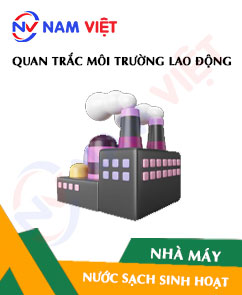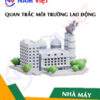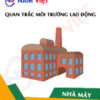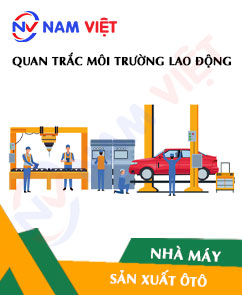Occupational environment monitoring at the factory producing household clean water
99,000 ₫
Note: The above price is calculated for one sample, the price may fluctuate depending on the area of the environment to be monitored and the movement of the market. For more accurate price support, please refer to the quotation table or contact directly with our consulting staff.
Environmental monitoring of household clean water production factories is a session of collecting, analyzing, and evaluating factors in the workplace that may be harmful to the health of workers.
Table of Contents
Toggle1. Overview of Household Clean Water Production Factories
a. What is a household clean water production factory?
A production factory for household clean water is an industrial facility specialized in the treatment and production of clean water for household use. Its primary function is to process raw water from natural sources such as streams, lakes, ponds, or wells to produce safe and clean water for everyday human activities.
The production process at a household clean water factory must comply with quality regulations and standards to ensure that the water produced meets safety and health requirements.

b. Production stages in a household clean water factory
The production stages in a household clean water factory typically include the following steps:
- Source water treatment: Water from raw sources (streams, lakes, ponds, wells) is collected and initially treated to remove impurities, sediments, and organic or inorganic compounds. This process may include mechanical filtration, sand filtration, sedimentation, and flocculation.
- Chemical treatment: After initial treatment, water undergoes chemical treatment to disinfect and eliminate pathogens and bacteria. Common disinfection methods include using chemicals such as chlorine or other agents capable of killing microorganisms. Other chemicals may be added to adjust pH or remove remaining organic and inorganic substances.
- Filtration: Water passes through filtration systems to remove fine particles, remaining sediments, and potential contaminants. Filtration methods include activated carbon filters, membrane filtration, nano-filtration, and other systems to eliminate small impurities and bacteria.
- Final sterilization: After filtration, water undergoes a final sterilization process to ensure all remaining bacteria and pathogens are eliminated. Methods may include chemical disinfectants such as chlorine or ultraviolet (UV) light treatment.
- Storage and distribution: Treated water is stored in tanks or pipeline systems for distribution to households, facilities, offices, or other points of use, ensuring that the water meets safety and quality standards.

c. Machinery used in household clean water production factories
Various machines and equipment are used in household clean water factories for treatment and production. Common machinery includes:
- Source water treatment systems:
- Mechanical filtration systems: Including sand filters, silica sand filters, and activated carbon filters to remove impurities and sediments.
- Flocculation and sedimentation systems: Utilizing sedimentation tanks, flocculation tanks, and precipitation tanks to form and settle unwanted substances.
- Chemical treatment systems:
- Chemical pumps: To supply and dilute chemicals such as chlorine, disinfectants, and other treatment agents into the water.
- Chlorine removal systems: Using devices like dechlorination tanks to remove or reduce residual chlorine after disinfection.
- Filtration systems:
- Sand filtration systems: Using sand filter tanks and valves to remove large particles and impurities.
- Membrane filtration systems: Using RO (reverse osmosis) or UF (ultrafiltration) membranes to remove impurities, bacteria, viruses, and dissolved substances.
- Final sterilization systems:
- UV sterilization systems: Using ultraviolet lamps to kill remaining bacteria and pathogens.
- Pumping and piping systems:
- Water pumps: To create pressure and transport water from the factory to points of use.
- Piping systems: Including PVC pipes, steel pipes, plastic pipes, and related equipment for water distribution.

d. Occupational diseases for workers in household clean water factories
Workers in household clean water production factories may be exposed to certain occupational diseases due to environmental factors and job-specific risks. Common occupational diseases include:
- Respiratory diseases: Employees working in water treatment areas may be exposed to organic vapors, dust, and chemicals that can irritate or damage the respiratory system, causing pneumonia, asthma, sinusitis, and throat infections.
- Skin diseases: Contact with chemicals and irritants such as detergents and disinfectants can lead to dermatitis, eczema, and other skin conditions.
- Infectious diseases: Exposure to contaminated water or pathogens may cause gastrointestinal infections, respiratory infections, and other communicable diseases.
- Toxic exposure: Long-term exposure to toxic substances such as lead, asbestos, or other chemicals may result in lead poisoning, cancer, or kidney problems.
- Work-related accidents: Industrial environments carry risks of slips, falls, collisions, or machinery-related injuries.
To prevent and minimize occupational disease risks, protective measures such as using personal protective equipment, following safety procedures, and employing safe work practices are crucial.

2. Overview of Occupational Environmental Monitoring Services
a. What is occupational environmental monitoring in household clean water factories?
Occupational environmental monitoring (or workplace environment measurement) at household clean water factories involves collecting, evaluating, and analyzing environmental indicators to implement timely measures, minimize environmental hazards to workers’ health, and prevent occupational diseases. Such monitoring is mandatory for household clean water production factories.
Occupational environmental monitoring plays a critical role in protecting and promoting workers’ health because employees are the primary resource of a business and directly contribute to its profits. Workers frequently exposed to hazardous factors above permissible limits are at risk of health issues and occupational diseases.
REGISTER FOR OCCUPATIONAL ENVIRONMENT MONITORING SERVICE
b. Nam Toan Viet’s occupational environmental monitoring program
Nam Toan Viet’s occupational environmental monitoring program is designed by monitoring engineers specializing in labor safety and environmental protection. Aimed at ensuring health and safety for workers, the program employs modern measurement methods to monitor air quality, water quality, microclimate, physical factors, dust, and more within the workplace. This program is crucial for maintaining a safe working environment and protecting employees’ health.
Additionally, Nam Toan Viet’s program plays an important role in researching and developing new solutions to improve workplace environmental quality. With the dedication and professionalism of the monitoring experts, Nam Toan Viet’s exclusive monitoring program represents a significant advancement in occupational safety management and environmental protection in Vietnam.

c. Standardization in workplace environmental measurement
Standardization in Nam Toan Viet’s workplace environmental measurement process is crucial for ensuring accurate and reliable results. The program follows recognized standards and procedures from the Ho Chi Minh City Department of Health. This ensures collected data is highly reliable for evaluating the workplace environment and making informed decisions to improve it for workers’ health.
Standardized procedures also guarantee that measurements are conducted by a highly skilled monitoring team with years of experience, allowing managers and specialists to trust results from An Toan Nam Viet and make accurate, valuable decisions to safeguard workers and the environment.
By applying standardization in environmental measurements, Nam Toan Viet demonstrates its commitment to a safe work environment, worker health protection, and contributes to improving occupational safety management and environmental protection quality in Vietnam.
d. Reporting monitoring results for household clean water factories
Monitoring results are compiled according to Form No. 04, Appendix III issued with Decree 44/2016/ND-CP and prepared in two copies: one for the workplace that contracted the monitoring service, and one kept by the monitoring organization.
Monitoring records must be stored indefinitely in accordance with legal regulations.

e. Frequency of occupational environmental monitoring as required by law
According to Clause 2, Article 18 of the Law on Occupational Safety and Hygiene 84/2015/QH13, employers must conduct workplace environmental monitoring to assess hazardous factors at least once a year.
f. Deadline for submitting occupational environmental monitoring reports
Reports must be submitted by December 31 each year. Enterprises operating production factories are required to submit monitoring results to the local Department of Health where the facility’s headquarters is located and where employees are working.
Whenever there are changes in technology, production processes, or facility upgrades that may introduce new hazards to workers’ health, enterprises must update occupational hygiene records to include harmful factors requiring monitoring.
g. Penalties for violations of occupational environmental monitoring by employers
According to Article 27 of Decree No. 12/2022/ND-CP dated January 17, 2022, on administrative penalties in labor, social insurance, and Vietnamese employees working abroad under contracts:
- Clause 2: Fines of VND 2,000,000 – 5,000,000 for employers who fail to publicly disclose monitoring results to employees at the workplace and at locations where hazardous factors are assessed, immediately after receiving monitoring results.
- Clause 3: Fines of VND 20,000,000 – 40,000,000 for employers who fail to conduct occupational environmental monitoring to control health hazards as required by law.
- Clause 4: Fines of VND 40,000,000 – 60,000,000 for employers who collude with monitoring organizations to falsify environmental monitoring results, without reaching criminal liability.
3. Harmful Environmental Factors for Workers in Household Clean Water Production Factories
In household clean water production factories, workers may be exposed to several harmful environmental factors that can affect their health. Here are some potential environmental factors that may exist in a household clean water production factory:
- Chemicals: The clean water production process may use chemicals such as disinfectants, water treatment chemicals, cleaning agents, and deodorizers. Prolonged exposure to these chemicals can cause skin, eye, and respiratory irritation, leading to health issues such as dermatitis, pharyngitis, respiratory problems, and allergies.
- Dust and particles: The production process can generate dust and particles from materials used in water filtration and treatment. Exposure to dust and particles may irritate the eyes, nose, throat, and respiratory system, causing respiratory issues and allergies.
- Noise: Some equipment in household clean water production factories can produce significant noise. Continuous and high levels of noise can cause stress, discomfort, and affect workers’ hearing.
- Physical working conditions: Household clean water production factories may have challenging working environments with high temperature, high humidity, and limited space. These conditions can cause fatigue, discomfort, and affect workers’ performance.
REGISTER FOR WORKPLACE ENVIRONMENT MONITORING SERVICE
4. Measures to Improve the Working Environment in Household Clean Water Production Factories
To improve the working environment in household clean water production factories and protect workers’ health, the following measures can be applied:
- Ensure safety and hygiene management systems: Establish and implement policies, procedures, and regulations regarding occupational safety and hygiene in the factory. Ensure strict compliance with labor safety and environmental hygiene regulations.
- Training and educating workers: Provide complete information and training on occupational safety, use of personal protective equipment, safe work procedures, and preventive measures against accidents and occupational diseases. Enhance workers’ awareness and knowledge of risks and preventive measures.
- Ensure workplace hygiene: Maintain and control air, water, and general workplace quality. Ensure proper ventilation and dust extraction to reduce exposure to harmful agents. Conduct hygiene, waste management, and recycling according to regulations.
- Provide personal protective equipment: Ensure workers are fully equipped with and properly use PPE such as masks, safety goggles, gloves, protective clothing, and safety shoes. Ensure PPE is regularly maintained and replaced on schedule.
- Periodic inspection and monitoring: Conduct regular inspections and monitoring of environmental factors such as air quality, noise levels, and other harmful agents. Evaluate and ensure compliance with labor safety and environmental hygiene standards.
- Encourage safety awareness and culture: Create a safe working environment and promote a safety-conscious mindset at all levels in the factory. Encourage workers to propose workplace improvement measures and provide feedback on safety and hygiene issues.
- Develop environmental protection policies: Implement environmental protection measures such as energy saving, production process optimization, and waste management. Use clean production technologies and methods to minimize negative impacts on the environment and workers’ health.
- Regularly conduct workplace environment monitoring in factories, collect and analyze harmful factors affecting workers, and adjust to reduce hazards to prevent occupational diseases.
5. Benefits of Regular Monitoring of Household Clean Water Production Factories
An Toan Nam Viet provides excellent benefits to businesses using workplace environment monitoring services according to Decree 44/2016/ND – CP on managing and controlling harmful factors in the working environment affecting workers.
- Businesses can proactively control harmful factors in the factory or production site.
- Receive consultation and recommendations on measures to reduce harmful factors and improve working environment quality.
- Indirectly protect human resources, a key factor in the company’s development process.
- Minimize the impact of occupational diseases on workers’ health, thereby reducing future treatment costs.
- Improve workers’ health, leading to better product quality and maintained production output.
- Comply with labor safety laws, avoiding legal risks.
- Enhance credibility and professionalism in all aspects, elevating the company’s brand.
Nam Viet’s environmental monitoring service is a solution to reduce occupational disease risks, contributing to a clean and high-quality working environment.

6. National Workplace Environment Monitoring Center
Workplace Environment Monitoring Center of Nam Viet is a professional unit for supervising and measuring the quality of workplace environments across all provinces in Vietnam. With a team of experienced monitoring specialists, the center uses modern measuring equipment to ensure accuracy and reliability.
In addition to providing monitoring services, the center supports clients in planning, managing, and following up on workplace environmental issues. Following the motto “customer-centric,” the center prioritizes client satisfaction, meets all customer needs, and commits to providing the best solutions for businesses.
REGISTER FOR WORKPLACE ENVIRONMENT MONITORING SERVICE
With investments in technology, equipment, and human resources, Nam Viet’s monitoring center has become one of the reputable units in workplace environment monitoring in Ho Chi Minh City, with the following objectives:
- We always value brand reputation and the quality of our service products.
- We provide clients with the best and most suitable solutions possible.
- Along with a team of experienced Masters and Engineers, committed to protecting the environment and benefiting businesses.
- By choosing Nam Viet Environmental Monitoring, your company will receive professional service from experts in the field and enjoy the best cost advantages.
The workplace environment monitoring process at Nam Viet includes the following basic steps:
- Before conducting monitoring, we ensure that all machinery and equipment are calibrated and adjusted according to legal regulations.
- Carry out the workplace environment monitoring process as committed to the Department of Health.
- Report workplace environment monitoring results honestly to the employer.
- If the monitoring results do not ensure safety for workers, Nam Viet will support corrective solutions and the workplace will implement:
- Implement measures to improve working conditions to minimize the impact of harmful factors and prevent occupational diseases.
- Organize health checks to detect occupational diseases and related illnesses early for employees in unsafe working conditions.
- Provide in-kind compensation to workers according to labor law regulations.

7. Workplace Environment Monitoring Price List
To help businesses conduct workplace environment monitoring professionally and effectively, Nam Viet provides clients with a comprehensive and reasonably priced monitoring service price list.
- Our price list provides detailed information about the costs of the monitoring services we offer, including travel, measurement, analysis, and reporting. Clients can be fully assured of the accuracy and reliability of the monitoring reports we provide.
- We commit to offering competitive and reasonable prices in the market and are always ready to consult and answer any questions about monitoring services promptly and professionally.
- With Nam Viet’s monitoring price list, clients can easily choose service packages that fit their needs. We commit to delivering the highest satisfaction with professional service quality.
No comments yet












Review Occupational environment monitoring at the factory producing household clean water
There are no reviews yet.